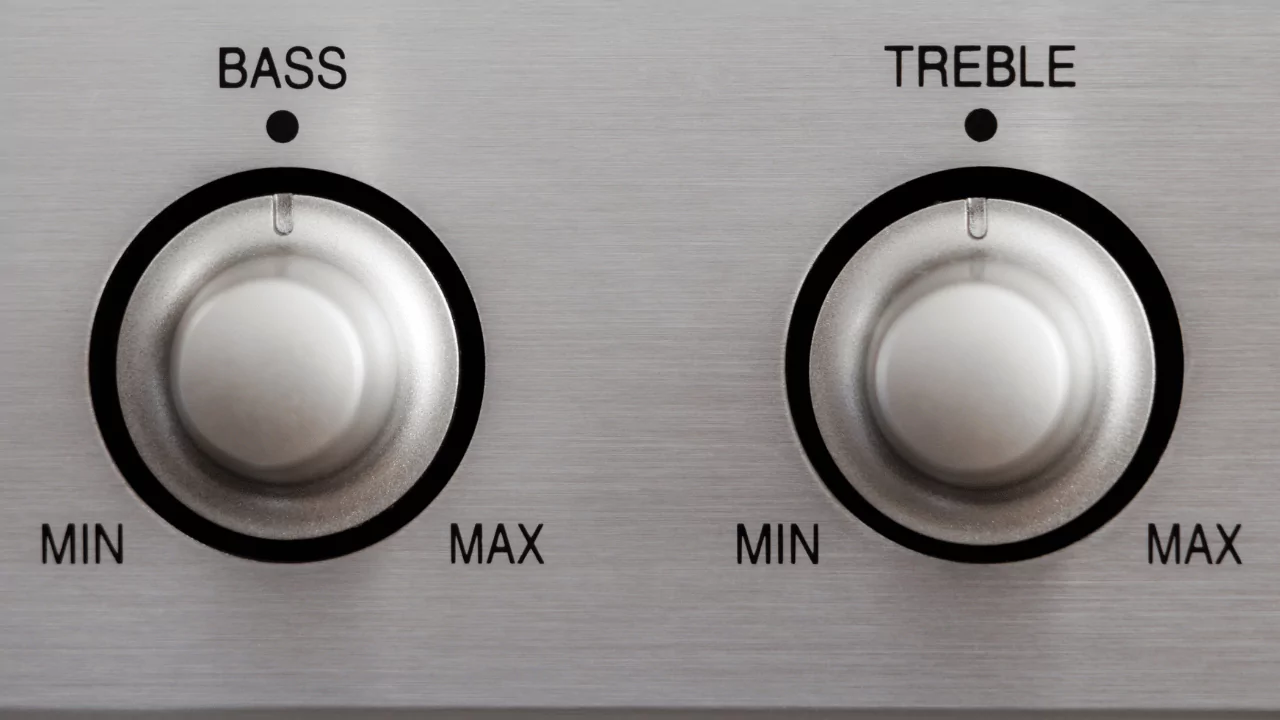When equalizing an audio track, you might get confused about how to balance bass and treble. Some try to increase the bass compared to the treble, but if not done in an accurate way it can create an unbalanced equalization. Thus, for a better output, it is always recommended that the treble should be higher.
In this guide let’s dive in and understand how to balance treble and bass for the best outcome.
In This Article:
What is the difference between Bass and Treble?
Bass and Treble have different frequency levels where the Bass consists of low musical sound and Treble consists of higher frequencies in terms of sound range audible to the human ear.
What does balancing Bass and Treble mean?
Balancing Bass and Treble refers to the process of adjusting relative levels of low frequency and high frequency. Here, low frequency is regarded as Bass, and the higher frequency is regarded as Treble. You can either use any equalization software to do it manually or use an Automatic Gain Control circuit (AGC).
How to balance Treble and Bass on a speaker?
To balance Treble and Bass on a speaker, you have to get to the taskbar, right-click on the speaker image, and select Playback Devices from the menu. You can either click on the speaker’s menu or choose an amplifier if you want to change the sound settings. Next, go through the Base Boost Box and select the Enhancement tab. This will help you to change the levels.
How to balance Bass and Treble on a computer?
To balance Bass and Treble on a computer, get to the notification bar, click on the speaker icon, and select the Mixer Link. This will help you to download the Volume Mixer. Next, get to the Master Volume and click on the speaker icon, you will find the option on the enhancement tab. Finally, click on Bass Boost to alter the levels.
Can an equalizer help you on balancing the Bass and Treble?
Yes, Equalizer is the best option for balancing Bass and Treble. It will help you to alter and manipulate the frequency of an audio track. This process is mostly implemented by recording studios as Equalizer works on both analog and digital forms. It helps to alter different elements of the sound and the outcomes in an appealing audio track.
Usually, equalizers have three basic levels: Bass, Mid, and Treble. So, you get a cohesive result for an audio track. The most commonly used equalizer is a graphical equalizer where you will find decibels on one axis and frequencies on the other axis. Thus, if you are a sound technician by profession, then you can address the frequency through the decibel scale.
If the Treble of an audio track is too loud, then you can reduce the volume level on any of the higher frequencies. Thus, it provides a balanced output and so you have to learn how to balance the bass and treble in the correct format.
Why is it always recommended for the Treble to be higher than Bass?
In terms of equalization the higher the treble than the base, the better outcome you can get and here are the rules that are applicable:
With a higher treble you get a better voice projection during the mix.
You need to consider voice projection while balancing Bass and Treble. It carries the song’s beat and the listener can tune in to the mix. If the Bass is increasing, then you may find the track vocals are getting distorted or affecting the listener’s ability to engage with the vocal projection.
Vocals usually appear in the range of 700 to 3K Hz frequency range and if you increase the bass the frequency gets overwhelmed, ruining the sound quality. However, there is no ideal setup that will provide your perfect outcome, rather you need to learn to balance so that the audio track feels smooth.
You also need to keep the best range keeping the bass below the treble.
Reduce the mid-range muddiness as this is the most problematic area for most audio technicians when the frequency range is 400 to 600 Hz. This problem also accelerates, if you increase the bass. So, it is always recommended to reduce the bass and keep the treble higher. You need to set the frequency range so that you can feel that the song does not crack and gets a unique character.
Keeping the treble and bass balance you can also reduce the low frequency rumble effect.
If the bass is higher than the treble, then it may cause distortions when you are playing any hum having a frequency below 440 Hz. Usually, these sounds travel longer, so a small change can also overpower the treble and ruin the song. So, you can use an equalizer to clean the audio data for better listening.
Tips for balancing Bass and Treble on audio track
You might get various ways of balancing Bass and Treble levels for an audio track, but you need to find the perfect mix of sound.
Here are the tips that you must follow to achieve a smooth balance in the equalization process:
- Always keep the treble higher than the bass.
- Try to avoid the common problem, such as mid-range frequency, low frequency, etc.
- Always adjust the speaker or computer audio settings.
At what range should you set the Bass, Mid and Treble?
For a perfect Bass, Mid, and Treble, it should be set in a ratio of 4:5 respectively of the system. You can also gain more control by highlighting the treble.
What is the frequency range of Bass, Mid and Treble?
Treble frequency range is 8000 to 15000 hertz, Mid-frequency is 400 to 2500 hertz and bass frequency is 60 to 120 hertz. If you are using an equalizer, then you will find more finer divisions for this frequency.
Does reduction in treble increase the bass?
No, if you increase the treble, it will not decrease the bass; rather, it will increase the amplitude of the frequencies and also provide you a more high-end note. On the other hand, if you increase the bass, then it won’t reduce the treble, but it provides a much lower end.





